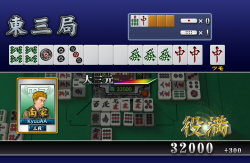Daisangen: Difference between revisions
m (→Tile pattern) |
m (→Sekinin barai) |
||
| (8 intermediate revisions by 2 users not shown) | |||
| Line 16: | Line 16: | ||
* [http://tenhou.net/0/?log=2014040608gm-000f-0000-be3f42d6&tw=3&ts=10 DSG] with [[tsuuiisou]] | * [http://tenhou.net/0/?log=2014040608gm-000f-0000-be3f42d6&tw=3&ts=10 DSG] with [[tsuuiisou]] | ||
}} | }} | ||
'''Daisangen''' {{kana|大三元}} is a | '''Daisangen''' {{kana|大三元}} is a [[yakuman]] scored when a hand has triplets/quads of all three [[dragon]]s. | ||
==Tile pattern== | ==Tile pattern== | ||
| Line 27: | Line 27: | ||
[[Image:Kyuu Yakuman Sega 00.png|thumb|right|250px|Daisangen in Sega Mahjong.]] | [[Image:Kyuu Yakuman Sega 00.png|thumb|right|250px|Daisangen in Sega Mahjong.]] | ||
[[Image:Real DSG pao.jpg|thumb|right|250px|Daisangen pao tsumo, with [[kamicha]] (left) fully liable.]] | [[Image:Real DSG pao.jpg|thumb|right|250px|Daisangen pao tsumo, with [[kamicha]] (left) fully liable.]] | ||
As the name implies, this yakuman depends on all three dragons. | |||
Daisangen is one of the three '''yakuman gosanke''' {{kana|役満御三家}}, or "the three big families of yakuman", along with [[suuankou]] and [[kokushi musou]]. Of the three, daisangen is the only one that can be played [[naki|open]]. | |||
As the name implies, this yakuman depends on all three dragons. If at least two copies of a dragon tile are unavailable, then completing a triplet becomes impossible, thus preventing the yakuman. | |||
===Viability=== | ===Viability=== | ||
Most | Most daisangen hands will call for the dragon tiles. One of the more reasonable hands to aim for daisangan is a hand with three pairs of dragons, which can pon any of them. Alternatively, a hand with two pairs of dragons can draw the third, then chase daisangen/shousangen if the third is paired. | ||
==Sekinin barai== | |||
{{main|Sekinin barai}} | |||
The rule of [[sekinin barai]] (i.e. pao) may apply to daisangen. It applies when a player has made open [[call]]s (pon/kan) with two of the dragons. When another player discards the third dragon, and that dragon is called so that all three dragons are in one hand, then the discarder is liable to pay for the yakuman. | |||
If the yakuman hand wins via ron, the discarder and ronned player each pay half. If the yakuman hand wins via tsumo, the discarder pays the entire hand. This effectively punishes a player for guaranteeing a yakuman. However, even if the third dragon is called for a kan, pao is still applied. | |||
==External links== | ==External links== | ||
Latest revision as of 08:03, 14 September 2024
| Type | Yakuman |
|---|---|
| Kanji | 大三元 |
| English | Big three dragons |
| Value | Yakuman |
| Speed | Slow |
| Difficulty | Hard |
Daisangen 「大三元」 is a yakuman scored when a hand has triplets/quads of all three dragons.
Tile pattern
- Note: This hand is also winnable with
 , but this hand would be shousangen instead.
, but this hand would be shousangen instead.
Development


Daisangen is one of the three yakuman gosanke 「役満御三家」, or "the three big families of yakuman", along with suuankou and kokushi musou. Of the three, daisangen is the only one that can be played open.
As the name implies, this yakuman depends on all three dragons. If at least two copies of a dragon tile are unavailable, then completing a triplet becomes impossible, thus preventing the yakuman.
Viability
Most daisangen hands will call for the dragon tiles. One of the more reasonable hands to aim for daisangan is a hand with three pairs of dragons, which can pon any of them. Alternatively, a hand with two pairs of dragons can draw the third, then chase daisangen/shousangen if the third is paired.
Sekinin barai
The rule of sekinin barai (i.e. pao) may apply to daisangen. It applies when a player has made open calls (pon/kan) with two of the dragons. When another player discards the third dragon, and that dragon is called so that all three dragons are in one hand, then the discarder is liable to pay for the yakuman.
If the yakuman hand wins via ron, the discarder and ronned player each pay half. If the yakuman hand wins via tsumo, the discarder pays the entire hand. This effectively punishes a player for guaranteeing a yakuman. However, even if the third dragon is called for a kan, pao is still applied.
External links
- Daisangen in Japanese Wikipedia
- 麻雀-役満 藤川孝治の大三元-New Wave Cup/MONDO TV (YouTube)
- Daisangen scored in the New Wave Cup
- Statistical analysis of pao
| |||||||||||||||||||||||||||||||
